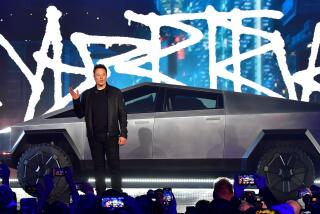GMâs Power Move
There was a time when General Motors Corp. was the auto industryâs unquestioned master of technology.
Throughout the 20th century, the worldâs largest auto maker has made a vast array of notable advancements. It was the first to develop the electric starter, V-8 engine, automatic transmission, air bag and catalytic converter.
But in the eyes of many consumers, GM--despite its own accredited four-year engineering college and a massive technology center employing hundreds of PhDs--squandered its technological talents in the 1970s and â80s. It was overshadowed by the Japanese, who offered pleasing vehicles that were often cheaper and of higher quality.
Now GM is poised to re-stake a claim as the auto technology leader. It hopes to do so on the basis of the EV1, the first modern vehicle engineered and designed specifically to operate on electric power, which is scheduled to go on sale in Southern California in early December.
âPart of our vision is to recapture our leadership in the publicâs mind as an innovative technology company,â John F. Smith Jr., GMâs chairman and chief executive, said when announcing EV1 production plans earlier this year.
GM touts the EV1 as the worldâs most energy-efficient vehicle, built on the most advanced vehicle platform ever designed. In developing it, the company was awarded 23 patents for a variety of new technologies coincidental to its electric power plant, many provided by its Hughes aerospace and Delco electronics units.
The EV1 resulted from Californiaâs mandate that 2% of the cars each auto maker sold in the state starting in 1998 be pollution-free. The mandate has since been postponed to 2003, when 10% of the vehicles must be zero-polluting. All major auto makers will begin selling pollution-free cars in the interim in order to build up to the mandated level.
GMâs sporty, two-seat vehicle will be sold only in Saturn dealerships in Southern California and Arizona. It is to be unveiled to the automotive media Tuesday at a news conference at Hughes Electronics Corp. in Westchester. The price is expected to be $35,000.
At first, consumers may be surprised by what is not in the EV1: engine, valves, pistons, spark plugs, timing belts, crankshaft, transmission, starter, clutch or exhaust system. There is no need to visit a gas station, change the oil or get a tuneup.
What the EV1 does have are world-record aerodynamics and a high-powered electric motor that can propel the car from zero to 60 mph in less than nine seconds.
âThis vehicle represents a wonderfully well-integrated new mode of transportation,â said Michael Gage, president of Calstart, a Burbank-based consortium dedicated to electric car development. âIn comparison to an internal combustion vehicle, itâs what a compact disc is to a long-play record.â
The EV1 evolved from the Impact âconcept carâ that GM unveiled at the 1990 Los Angeles Auto Show. But it shares only two parts with the old Impact: the door handles and the radio.
The EV1 is clearly the most advanced electric vehicle ever produced by a major manufacturer, although some critics say GM compromised its efforts in a bid to create a vehicle that performed like existing gasoline-powered cars, with the same safety, comfort and convenience features and enough range to satisfy most commuters.
But it represents GMâs best guess at what will sell--the biggest unanswered question facing the auto industry as it reenters the age of battery-powered cars. Its commercial success or failure could profoundly affect the fate of a whole new generation of pollution-free vehicles.
Here are some of its features:
Aerodynamics. The EV1 was designed to have the shape of a falling raindrop. The rear wheels are about 9 inches closer together than the front wheels. The underbody is sealed because there is no exhaust pipe or need to eliminate engine heat. There is no grille.
The result is the most aerodynamic vehicle ever sold. The EV1âs coefficient of drag--a measure of friction and wind resistance--is just 0.19. The most sleekly designed gas-powered cars have a coefficient of drag of 0.30 to 0.35. The aero design was necessary to help extend vehicle range.
Structure. It has the lightest skeletal structure ever used in a production vehicle. The 290-pound aluminum frame accounts for just 10% of the vehicleâs weight, half that of normal vehicles. It is held together by a combination of welds, rivets and structural adhesives.
âIt is weld-bonded, actually glued,â said John Bereisa, the vehicleâs chief propulsion engineer.
The process gives the car a very high structural stiffness that translates into better ride and handling and fewer shakes and rattles.
The body panels are made of composite materials similar to those used on the Corvette, Camaro and Saturn. The plastic panels weigh 50% less than steel sheet metal.
Batteries. The vehicleâs âfuel tankâ is a T-shaped battery pack of 26 lead-acid modules. It weighs 1,175 pounds and contains the energy equivalent of about two gallons of gas--enough to power the car 70 to 90 miles before it needs recharging.
Battery technology remains the missing link in electric car development, seriously limiting driving range. Like all auto firms, GM is working on more advanced batteries, particularly nickel-metal hydride. When more advanced batteries are ready, they can replace the EV1 lead-acid pack with no modification.
Charger. The car can be fully recharged at 220 volts in three hours using a patented GM system.
EV1 owners must have a charger system installed at their home or place of business. The charger, which will be leased along with the car, is a narrow, 4-foot-high unit. A lightweight paddle is inserted into the vehicleâs charge port and power is transferred via a magnetic field.
GM is pushing to have its inductive system adopted as an industry standard, but Ford and Chrysler are continuing development of a conductive system that would allow similar charging with an on-board unit.
Ignition. The EV1 uses a keyless ignition system, which GM claims is the first to be brought to market. The driver punches in an electronic code on the center console and presses a button to start the car. The same code can be used to unlock the doors.
Air conditioning. Conventional vehicles use heat generated by the engine to warm the passenger compartment. But because there is little waste heat in an electric vehicle, another solution had to be found.
GM turned to a heat pump to cool and heat the EV1âs interior using a third of the energy of a conventional unit. However, the system will keep passengers warm only in temperatures above 30 degrees. âBelow that, people will want to have long johns,â said Ellis. For colder climates, future electric vehicles are expected to use heat pumps in combination with small fuel-fired heaters.
Drive unit. A 137-horsepower AC (alternating current) induction motor converts battery energy into torque for propulsion. The computer-controlled unit can provide the EV1 with quick acceleration, but pedal-to-the-metal starts can drain the batteries quickly and reduce range.
Power electronics. Mounted above the electric motor, the propulsion control module contains the semiconductors, switches and other power electronics that control much of the functions of the EV1. GM executives say there are enough electronics on board to power two 50,000-watt radio stations.
Brakes. The EV1 has âregenerative braking.â When the brake is applied, the drive motor becomes a generator that slows the vehicle while recapturing the vehicleâs kinetic energy and returning it to the battery.
The power-assisted anti-lock brakes are electrically applied. Front disc brakes are electro-hydraulic. In an industry first, the rear drums are fully electric, eliminating the need for hydraulic lines or parking brake cables.
Tires. The EV1 uses advanced steel-belted radial tires developed by Michelin. They are mounted on the lightest 14-wheels ever used. The tires use a special rubber compound and are inflated to 50 pounds per square inch, compared with 35 pounds for normal tires. The hardness of the tires makes for low rolling resistance.
There is no spare or jack because the tires are self-sealing and equipped with a pressure monitor to warn of a puncture.
(BEGIN TEXT OF INFOBOX / INFOGRAPHIC)
Zero to 60 in 220v
The EV1, which in December becomes the first electric vehicle marketed by a major auto maker in more than 75 years, is not your fatherâs Oldsmobile. In creating the sporty two-seater, which will be available only by lease at a suggested retail price of $35,000, General Motors obtained 23 patents for a variety of technologies. Some of the unique features of the EV1:
Charger: The car is fully rechargeable in three hours at a 220-volt charger installed in the ownerâs garage. A plastic paddle is inserted into the vehicleâs charge port and power is transferred via a magnetic field.
Drive unit: A 137-horsepower, alternating-current induction motor converts battery energy into torque for propulsion. The computer-controlled, 150 pound unit requires no maintenance. Vehicle goes from zero to 60 mph in less than nine seconds.
Aerodynamics: Thanks to its teardrop shape--the rear wheels are 9 inches closer together than the front wheels--and a sealed underbody, the EV1 is the most aerodynamic of vehicles, with a drag coefficient of 0.19. There is no exhaust pipe or need to dissipate heat.
Structure: The aluminum car frame is the worldâs lightest. At 290 pounds, it accounts for just 10% of overall weight, compared with the normal 20%. It is also recyclable.
Brakes: When the brakes are applied, the drive motor becomes a generator that slows the vehicle while recapturing the carâs kinetic energy, using it to partially recharge the battery.
Source: General Motors






